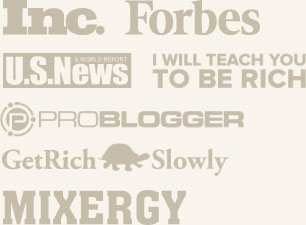The Complete Guide to Creating An Information Product
 Do you believe it takes a lot of money to create an information product? How, exactly, does one go about creating an information product? Let’s take a look at the actual development process for an information product.
Do you believe it takes a lot of money to create an information product? How, exactly, does one go about creating an information product? Let’s take a look at the actual development process for an information product.
My Upcoming Product
In January, I will formally release my first information product! It’s called Guest Post Secrets, and it’s designed to help up-and-coming bloggers get a massive wave of thousands of targeted visitors and subscribers to their blog. Guest Post Secrets will sell for under $50, which will be well worth it when you consider how much it will grow your blog.
Guest Post Secrets consists of approximately thirty minutes of video content that I created using Camtasia–a piece of software that records your computer screen while you talk into an attached microphone.
In Guest Post Secrets, I explain what a guest post is and how much traffic it can drive to your blog. A typical guest post I write sends me about 4,000 new visitors. Over half of my 7,000 subscribers have found me through guest posts I’ve done, and my last guest post brought me over 700 new subscribers. I believe anyone can grow a huge blog by guest posting, but most bloggers don’t know how to guest post or aren’t getting responses when they email other bloggers for guest posts.
The current guest posting guides that are out there aren’t very deep. Guest Post Secrets goes crazy deep–showing you the exact email I send to top bloggers to get them to say “yes”, exactly what you need to say in your followup email, how to format your guest post, and examples of guest posts anyone can write to drive tons of traffic back to their blog.
All told, it’s about 30 minutes of video content, plus a “10 Mistakes” PDF that goes over the most common guest post mistakes, plus the email text that you can download and send to top bloggers–and some as-yet-unnanounced bonuses that are going to absolutely rock!
Earlier, I wrote about a four-step process I use whenever I create a new product. I used this method to create Guest Post Secrets. Now, I’ll run it through with you, show you the cost breakdown, as well as showing you each step I took to make my three videos into a product.
The Breakdown–Step 1: Determine A Market
I created my Blog Success Manifesto and released it for free. With over 2,000 downloads in the first few months, plus rave reviews and tons of people asking me for more information, I quickly determined that there was a market of bloggers who wanted more traffic to their blogs.
But a lingering question remained: Would up-and-coming bloggers pay for quality information, or did they all only want free stuff?
Step 2: Decide What Your Product Will Be
Earlier in 2009, I quietly took on a few clients who paid a monthly fee and got personal access to me. They were all interested in learning about blogging.
I created many videos before finally creating three videos, in a series, that I felt summed up the best way to quickly get traffic and grow a blog–no matter whether you were starting from scratch or just wanted to grow your community faster.
I had a decision to make: Should I release this now, as a less expensive product, or keep adding to it and making it a bigger, more expensive product?
I’ve heard conflicting advice from this from other Internet marketers. Some say releasing a less expensive product undercuts your value and time spent creating the product. Others say it helps establish you and get your name out there.
Finally, I decided I needed to get a product out there. I couldn’t know whether people were willing to pay for this information without releasing a product into the market. Releasing a quality, yet inexpensive, product, would allow me to test the market quickly and either poll my customers to create a larger product later or–if it bombed–to move on to a different, more lucrative market.
Step 3: Actually Create the Product
I sent my unpolished videos off to a fantastic video editor in the Philippines, who, for $3/hour, edited out all my pauses, “um”s, and mistakes, and sent them back to me as Flash video files.
Total spent:
Camtasia: $292 at Amazon (cheaper than Camtasia’s website)–but get the 30-day free trial to start out.
Video editing: Under $10.
Next step: I needed a name! I brainstormed several names in my trusty notebook, finally deciding on Guest Post Secrets. I registered guestpostsecrets.com through eNom–my chosen domain name reseller. I already have hosting through ServInt.
Total cost to register the domain name: $10.
I’ve been a web designer since 1996, but design is one of the easiest things to outsource–if you know where to look. I had some good recommendations in this area, and decided quickly on Killer Covers.
I immediately ordered a Killer Website Brand Pack from Killer Covers, and they turned around a fantastic mini-site design in a couple days, complete with HTML files I could edit myself and insert my sales letter into. I also had a professional-looking cover graphic for my product. (If you’ve ever wondered how product creators get those graphics that look like product boxes, CD cases, or book covers, Killer Covers does exactly that!)
Total cost for Killer Covers website and e-cover design: $297. (Note: If you just want a cover, that’s a lot cheaper…check Killer Covers for more information.)
Meanwhile, Lisa, my primary VA, was building out the back end of the product. She installed Wishlist Member, set up WordPress with the correct plugins, and inserted the videos into the site. She configured Wishlist Member to work with my shopping cart and merchant account. I could now accept payments!
I added some minor site tweaks, and the back end was ready in just a couple days.
Total costs: Merchant account: Powerpay = $10/month (plus transaction fees)
Shopping cart: 1ShoppingCart = $99/month
Lisa’s time: 5 hours @ $26/hour = $130
Wishlist Member: $97 for a 1-site license
I also had another VA work on what would become an amazing upsell product: a list of 100+ blogs that accept guest posts. He spent 12 hours compiling a great list of blogs, complete with Alexa rankings, categories, etc. This has already been worth its weight in gold to me alone; I’ve discovered several popular blogs I was unaware of that I can write guest posts for.
I’ll sell this as an optional add-on for a low price.
Cost: 12.5 hours at $3.33/hour: $41.63.
Step 4: Sell Your Product
Creating a sales letter can definitely be outsourced, but as a writer, this was one thing I decided to take on myself.
I’m going to be frank: Writing a sales letter, especially if you haven’t done it before, isn’t easy. It’s also absolutely nothing like writing a blog post or a newspaper article–the two writing jobs I have a lot of experience with.
The best way to write a sales letter is to download a swipe file of other great sales letters and copy them, sentence for sentence, making them work with your product. Changing from the “voice” of a blog post, where most of the writing is about me, to the voice of a sales letter, which is all about you and your desires, is hard.
I believe copywriting is a skill that can be learned, but it’s not something you’re going to learn overnight. It is probably worth it to pay a professional copywriter for a “copy critique.” I did this and had two copywriters basically rip my sales letter apart. It was a huge blow to my ego, but I have to admit the revised letter cleaned up nicely.
There’s still more work to do on my sales letter, but it’s already far better than my first draft. Ironically, you will probably find that writing the sales letter will take you as much or more time than creating the actual product. That’s to be expected.
I did shoot a video for the sales letter, too, remembering to put myself in my buyers’ position. I uploaded it to YouTube. Then, when a copywriter said it was too long (at 7 minutes), I cut a minute out of it and uploaded it again today.
Hardware and Other Supplies
I needed a microphone to do the audio recording part of the product with Camtasia. I picked up an Audio-Technica AT2020 USB microphone and a pop filter, plus a better microphone stand. This makes the audio portion of the videos sound fantastic.
Total cost for microphone, pop filter and stand: ~$135.
For the sales letter video, I used my Canon HG10 camcorder (which has since been supplanted by the Canon HG21) on a tripod mount, and shot in HD. I also recently invested in a wireless lavalier microphone so I don’t sound so “echo-y” on video.
This setup will not only help me with this product, but with many future products. Of course, if you don’t have the budget for a full-blown video setup, start with an inexpensive Flip HD camera. I do recommend budgeting for the above microphone setup, however; it’s well worth the cost.
Total Costs
At this point, I’d say I have well over 40 hours of personal time invested in this product, in addition to the costs above.
My total costs were $2618.63, not including copy critiques or my swipe file.
My recurring costs are $107/month for my shopping cart and merchant account.
If you subtract out the video camera and the wireless lavalier microphone that goes with it, and instead buy a $149 Flip camera, and create your product within Camtasia’s 30-day free trial window, your total costs would be $1176.63.
Will This Product Make Money?
This is the fun (and somewhat scary!) part of being an entrepreneur. You invest tons of time, and at least a bit of money. Unlike a job, you’re not guaranteed payment for that time. You may release a product and it totally bombs–or you may release a product where your total earnings make you an hourly wage that would make any bigwig CEO proud.
The only way to truly know if your product will be successful is to sell it. Don’t let yourself get overwhelmed, or think “I don’t have thousands of dollars to spend!” If you have more time than money, use your time to hone your copywriting and content creation skills. If you have some money, as little as a few hundred dollars is all you’ll probably need to develop a great product.
What to Do With A Minimal Budget?
Assuming you already know what product you plan to create, and have a name for it…
If I only had $300 to spend, no question, I’d spend it on a Killer Covers web design. You can borrow a microphone and get a free trial of Camtasia–but web design is harder to do yourself, and it’s worth it to pay Killer Covers instead of spending hours doing it yourself. (This, coming from someone who made her living as a full-time Web designer and developer for years!)
Recommended Reading:
- My Instant Swipe File. Very useful product, especially with its current low price. I purchased it and am using the template inside it to help develop my sales letter.
Are you planning to create an information product in 2010? Have questions about creating a product? Let me know in the comments!


